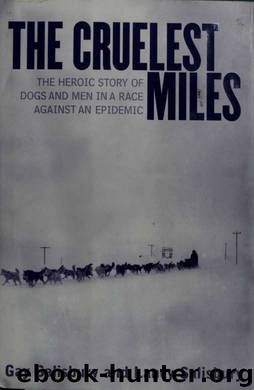The Cruelest Miles: the Heroic Story of Dogs and Men in a Race Against an Epidemic by Gay Salisbury

Author:Gay Salisbury [Salisbury, Gay]
Language: eng
Format: epub
Tags: Illness & Disease, Dogs, Alaska, Nonfiction, History
ISBN: 978-0393019629
Publisher: W. W. Norton & Co.
Published: 2003-01-01T05:00:00+00:00
8: Along the Yukon River
A nineteenth century explorer's illustration of Athabaskan travel along the Yukon River, the central highway of Alaska's Interior.
"There are a few lonely places in this world, and the wastes of the great Alaskan Interior are the loneliest of them all."
- Traveler Henry W. Elliott, 1886
For four hours, Bill Shannon sat huddled at the stove in Campbell's roadhouse, drinking coffee and allowing the heat to wash over him. Finally, he was ready to take some food to give him the strength to continue the journey. Despite all that had happened, Shannon had not lost his resolve. He would complete the remaining twenty-two miles to Tolovana. He had given his word that he would.
As Dr. Beeson in Anchorage had instructed, Shannon had taken the serum inside so it would not freeze, unwrapping the layer of fur and canvas and dangling the container from the rafters above to share the warmth of the stove. The cabin was probably no warmer than 50 degrees, but in comparison with the temperature outside it felt tropical. Just before seven o'clock on Wednesday morning, now working on his sixth cup of coffee, Wild Bill took a last pull from his cup and went outside to check on his dogs. Although by the clock it was early morning, it would be several more hours before dawn finally drove out the darkness of the Alaskan night.
Earlier that night, after helping Shannon into the roadhouse, Johnny Campbell led the dogs to a lean-to, where he fed them and let them rest. But one look suggested that they needed far more than an hour or two of downtime. Several were suffering from what mushers in those days described as "lung scorching," a condition in which they believed a dog's lungs were turned black as coal from frostbite. Lung scorching was more conjecture than proven fact. Mushers rarely, if ever, performed autopsies on their dogs and only imagined the havoc the cold air was causing them. Modern veterinarian medicine tells us that a dog suffering from working too hard in the severe cold more likely has a pulmonary hemorrhage. Sustained heavy exertion in dry, minus-50-degree weather can freeze and burst the minute vessels of a dog's bronchial tree and damage the delicate alveoli, the tiny sacs in the lungs where the transfer of oxygen to the blood takes place. The lungs do not turn black, but fill up with blood. Although the dog finds it harder and harder to breathe, he will keep running, spurred on by his teammates, until eventually he drowns in his own blood or passes out from oxygen deprivation. In either event, he will soon be dead. The initial warning signs are bleeding from the mouth and nose, where the lining of mucous membrane becomes brittle and cracks in the cold.
When Shannon checked on the dogs, Cub, Jack, and Jet could barely struggle to their feet. The trip to Tolovana was at least another three to four hours and Shannon knew that these dogs would not make the distance.
Download
This site does not store any files on its server. We only index and link to content provided by other sites. Please contact the content providers to delete copyright contents if any and email us, we'll remove relevant links or contents immediately.
| Administration & Medicine Economics | Allied Health Professions |
| Basic Sciences | Dentistry |
| History | Medical Informatics |
| Medicine | Nursing |
| Pharmacology | Psychology |
| Research | Veterinary Medicine |
Periodization Training for Sports by Tudor Bompa(8215)
Why We Sleep: Unlocking the Power of Sleep and Dreams by Matthew Walker(6659)
Paper Towns by Green John(5141)
The Immortal Life of Henrietta Lacks by Rebecca Skloot(4552)
The Sports Rules Book by Human Kinetics(4348)
Dynamic Alignment Through Imagery by Eric Franklin(4179)
ACSM's Complete Guide to Fitness & Health by ACSM(4021)
Kaplan MCAT Organic Chemistry Review: Created for MCAT 2015 (Kaplan Test Prep) by Kaplan(3972)
Introduction to Kinesiology by Shirl J. Hoffman(3744)
Livewired by David Eagleman(3730)
The Death of the Heart by Elizabeth Bowen(3580)
The River of Consciousness by Oliver Sacks(3574)
Alchemy and Alchemists by C. J. S. Thompson(3484)
Bad Pharma by Ben Goldacre(3397)
Descartes' Error by Antonio Damasio(3250)
The Emperor of All Maladies: A Biography of Cancer by Siddhartha Mukherjee(3114)
The Gene: An Intimate History by Siddhartha Mukherjee(3075)
The Fate of Rome: Climate, Disease, and the End of an Empire (The Princeton History of the Ancient World) by Kyle Harper(3035)
Kaplan MCAT Behavioral Sciences Review: Created for MCAT 2015 (Kaplan Test Prep) by Kaplan(2960)
